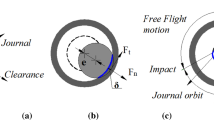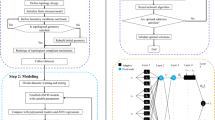Abstract
Even if today’s manufacturing technology has great advances, clearance between joint parts in a multibody system is inevitable due to the assemblage and relative motion of neighbour links. If a joint has excessive clearance size, it leads to negative effects on the system performance and unforeseeable power consumption occurs during the life-cycle of a mechanical system. Instant change at the electric current makes the actuator lifetime shorter. In this study, actuator current fluctuation and power consumption in the spatial multibody system are investigated. Classic and compliant slider-crank mechanisms with clearance and flexible joints are studied together. Hertz contact theory comprising the model of Lankarani and Nikravesh is considered to comment on the joint forces on the power consumption. Coulomb’s friction law is preferred to evaluate the friction behaviours. A dynamic neural predictor is also designed to determine the current fluctuation for the different working parameters. Experimental data is used for the prediction stability of the neural model. The results outline that the clearance joint has a dominant effect on the power consumption and the current fluctuation of the actuator. The designed neural predictor has stable and superior performances to predict and estimate the current fluctuation. In the design stage of the system, therefore, researchers can judge the power consumption of similar mechanical systems having imperfect joints and may select the suitable actuator for real working conditions.










Similar content being viewed by others
References
ASME, ANSY, Y14.5M-1994, Dimensional and Tolerancing, New York (1994)
Flores, P., Ambrósio, J., Claro, J.C.P., Lankarani, H.M.: Kinematics and dynamics of multibody systems with imperfect joints: models and case studies. In: Pfeiffer, F., Wriggers, P. (eds.) Lecture Notes in Applied and Computational Mechanics, vol. 34. Springer, Berlin (2008)
Kant, G., Sangwan, K.S.: Predictive modelling for energy consumption in machining using artificial neural network. Proc. CIRP 37, 205–210 (2015)
Owda, H.M.H., Omoniwa, B., Shahid, A.R., Ziauddin, S.: Using artificial neural network techniques for prediction of electric energy consumption. arXiv:1412.2186 [cs.NE] (2014)
Schiehlen, W., Iwamura, M.: Minimum energy control of multibody systems utilizing storage elements. In: ASME Proceedings 7th Int. Conf. Multibody Sys. Nonlinear Dyn. and Control USA, pp. 1919–1926 (2009)
Mori, M., Fujishima, M., Inamasu, Y., Oda, Y.: A study on energy efficiency improvement for machine tools. CIRP Ann. 60(1), 145–148 (2011)
Xie, N., Duan, M., Chinnam, R.B., Li, A., Xue, W.: An energy modeling and evaluation approach for machine tools using generalized stochastic Petri Nets. J. Clean. Prod. 113, 523–531 (2016)
Tuma, J., Blecha, P., Zahalka, J., Tuma, Z.: Prediction method for electrical energy consumption of the machine tool in the usage stage. In: Mechatronics—Mechatronika 16th Int Conf., Czech Republic, vol. 248, p. 253 (2014)
Erkaya, S., Doğan, S.: A comparative analysis of joint clearance effects on articulated and partly compliant mechanisms. Nonlinear Dyn. 81, 323–341 (2015)
Erkaya, S., Doğan, S., Şefkatlioğlu, E.: Analysis of the joint clearance effects on a compliant spatial mechanism. Mech. Mach. Theory 104, 255–273 (2016)
Erkaya, S.: Experimental investigation of flexible connection and clearance joint effects on the vibration responses of mechanisms. Mech. Mach. Theory 121, 515–529 (2018)
Machado, M., Costa, J., Seabra, E., Flores, P.: The effect of the lubricated revolute joint parameters and hydrodynamic force models on the dynamic response of planar multibody systems. Nonlinear Dyn. 69, 635–654 (2012)
Flores, P., Ambrósio, J., Claro, J.C., Lankarani, H.M.: Dynamics of multibody systems with spherical clearance joints. J. Comput. Nonlinear Dyn. 1, 240–247 (2006)
Flores, P., Koshy, C., Lankarani, H., Ambrósio, J., Claro, J.C.P.: Numerical and experimental investigation on multibody systems with revolute clearance joints. Nonlinear Dyn. 65, 383–398 (2011)
Tian, Q., Liu, C., Machado, M., Flores, P.: A new model for dry and lubricated cylindrical joints with clearance in spatial flexible multibody systems. Nonlinear Dyn. 64, 25–47 (2011)
Flores, P., Lankarani, H.M.: Spatial rigid-multibody systems with lubricated spherical clearance joints: modeling and simulation. Nonlinear Dyn. 60, 99–114 (2010)
Flores, P., Ambrósio, J., Claro, J.C.P., Lankarani, H.: Spatial revolute joints with clearances for dynamic analysis of multi-body systems. Proc. Inst. Mech. Eng., Proc., Part K, J. Multi-Body Dyn. 220, 257–271 (2006)
Geng-xiang, W., Hong-zhao, L., Pei-sheng, D.: Dynamic modeling for a parallel mechanism considering spherical joint clearance. J. Vib. Shock 10, 009 (2014)
Zheng, E., Zhu, R., Zhu, S., Lu, X.: A study on dynamics of flexible multi-link mechanism including joints with clearance and lubrication for ultra-precision presses. Nonlinear Dyn. 83, 137–159 (2016)
Tian, Q., Zhang, Y., Chen, L., Yang, J.J.: Simulation of planar flexible multibody systems with clearance and lubricated revolute joints. Nonlinear Dyn. 60, 489–511 (2010)
Li, J., Yan, S., Guo, F., Guo, P.: Effects of damping, friction, gravity, and flexibility on the dynamic performance of a deployable mechanism with clearance. J. Mech. Eng. Sci. 227(8), 1791–1803 (2012)
Erkaya, S., Uzmay, İ.: Effects of balancing and link flexibility on dynamics of a planar mechanism having joint clearance. Sci. Iran. 19, 483–490 (2012)
Khemili, I., Romdhane, L.: Dynamic analysis of a flexible slider-crank mechanism with clearance. Eur. J. Mech. A, Solids 27, 882–898 (2008)
Zheng, E., Zhou, X.: Modeling and simulation of flexible slider-crank mechanism with clearance for a closed high speed press system. Mech. Mach. Theory 74, 10–30 (2014)
Li, Y., Chen, G., Sun, D., Gao, Y., Wang, K.: Dynamic analysis and optimization design of a planar slider-crank mechanism with flexible components and two clearance joints. Mech. Mach. Theory 99, 37–57 (2016)
Yaqubi, S., Dardel, M., Daniali, H.M., Ghasemi, M.H.: Modeling and control of crank-slider mechanism with multiple clearance joints. Multibody Syst. Dyn. 36, 143–167 (2016)
Muvengei, O., Kihiu, J., Ikua, B.: Dynamic analysis of planar rigid-body mechanical systems with two-clearance revolute joints. Nonlinear Dyn. 73, 259–273 (2013)
Flores, P.: A parametric study on the dynamic response of planar multibody systems with multiple clearance joints. Nonlinear Dyn. 61, 633–653 (2010)
Tian, Q., Zhang, Y., Chen, L., Flores, P.: Dynamics of spatial flexible multibody systems with clearance and lubricated spherical joints. Compos. Struct. 87, 913–929 (2009)
Venanzi, S., Parenti-Castelli, V.: A new technique for clearance influence analysis in spatial mechanisms. J. Mech. Des. 127, 446–455 (2005)
Erkaya, S., Uzmay, İ.: A neural–genetic (NN–GA) approach for optimising mechanisms having joints with clearance. Multibody Syst. Dyn. 20, 69–83 (2008)
Ahmedalbashir, M., Romdhane, L., Lee, J.: Dynamics of a four-bar mechanism with clearance and springs—modeling and experimental analysis. J. Mech. Sci. Technol. 31(3), 1023–1033 (2017)
Jia, X., Jin, D., Ji, L., Zhang, J.: Investigation on the dynamic performance of the tripod-ball sliding joint with clearance in a crank-slider mechanism. Part 1. Theoretical and experimental results. J. Sound Vib. 252, 919–933 (2002)
Koshy, C.S., Flores, P., Lankarani, H.M.: Study of the effect of contact force model on the dynamic response of mechanical systems with dry clearance joints: computational and experimental approaches. Nonlinear Dyn. 73, 325–338 (2013)
Erkaya, S.: Clearance-induced vibration responses of mechanical systems: computational and experimental investigations. J. Braz. Soc. Mech. Sci. Eng. 40, 90 (2018)
Erkaya, S.: Prediction of vibration characteristics of a planar mechanism having imperfect joints using neural network. J. Mech. Sci. Technol. 26, 1419–1430 (2012)
Erkaya, S.: Effects of joint clearance on motion accuracy of robotic manipulators. Stroj. Vestn. 64(2), 82–94 (2018)
Tian, Q., Flores, P., Lankarani, H.M.: A comprehensive survey of the analytical, numerical and experimental methodologies for dynamics of multibody mechanical systems with clearance or imperfect joints. Mech. Mach. Theory 122, 1–57 (2018)
Erkaya, S.: Investigation of joint clearance effects on actuator power consumption in mechanical systems. Measurement 134, 400–411 (2019)
Askari, E., Flores, P., Dabirrahmani, D., Appleyard, R.: Dynamic modeling and analysis of wear in spatial hard-on-hard couple hip replacements using multibody systems methodologies. Nonlinear Dyn. 82, 1039–1058 (2015)
Flores, P., Ambrósio, J., Claro, J.C.P., Lankarani, H., Koshy, C.: A study on dynamics of mechanical systems including joints with clearance and lubrication. Mech. Mach. Theory 41, 247–261 (2006)
Bai, Z.F., Zhao, Y.: A hybrid contact force model of revolute joint with clearance for planar mechanical systems. Int. J. Non-Linear Mech. 48, 15–36 (2013)
MSC.ADAMS: Automatic Dynamic Analysis of Mechanical Systems, MSC Software Corporation (2013)
Erkaya, S., Su, Ş., Uzmay, İ.: Dynamic analysis of a slider-crank mechanism with eccentric connector and planetary gears. Mech. Mach. Theory 42, 393–408 (2007)
Howell, L.L.: Compliant Mechanisms. Wiley, New York (2001)
Krenker, A., Bešter, J., Kos, A.: Introduction to the artificial neural networks. In: Suzuki, K. (ed.) Artificial Neural Networks-Methodological Advances and Biomedical Applications, pp. 3–18. InTech, London (2001)
Lin, T., Horne, B.G., Tino, P., Giles, C.L.: Learning long-term dependencies in NARX recurrent neural networks. IEEE Trans. Neural Netw. 7(6), 1329–1338 (1996)
Chan, R.W.K., Yuen, J.K.K., Lee, E.W.M., Arashpour, M.: Application of nonlinear-autoregressive-exogenous model to predict the hysteretic behaviour of passive control systems. Eng. Struct. 85, 1–10 (2015)
Eski, İ., Erkaya, S., Savaş, S., Yildirim, Ş.: Fault detection on robot manipulators using artificial neural networks. Robot. Comput.-Integr. Manuf. 27, 115–123 (2011)
Chen, S., Bilings, S.A., Grant, P.M.: Non-linear system identification using neural networks. Int. J. Control 51(6), 1191–1214 (1990)
Leontaritis, I.J., Bilings, S.A.: Input-output parametric models for non-linear systems: Part I: Deterministic non-linear systems. Int. J. Control 41(2), 303–328 (1985)
Shiau, T.N., Tsai, Y.J., Tsai, M.S.: Nonlinear dynamic analysis of a parallel mechanism with consideration of joint effects. Mech. Mach. Theory 43(4), 491–505 (2008)
Erkaya, S.: Analysis of the vibration characteristics of an experimental mechanical system using neural networks. J. Vib. Control 18(13), 2059–2072 (2012)
Yildirim, Ş., Erkaya, S., Eski, İ., Uzmay, İ.: Noise and vibration analysis of car engines using proposed neural network. J. Vib. Control 15(1), 133–156 (2009)
Erkaya, S.: Investigation of balancing problem for a planar mechanism using genetic algorithm. J. Mech. Sci. Technol. 27, 2153–2160 (2013)
Erkaya, S., Uzmay, İ.: Effects of balancing and link flexibility on dynamics of a planar mechanism having joint clearance. Sci. Iran. 19(3), 483–490 (2012)
MATLAB: Neural Network Toolbox. The MathWorks Inc., Natick (2013)
Author information
Authors and Affiliations
Corresponding author
Additional information
Publisher’s Note
Springer Nature remains neutral with regard to jurisdictional claims in published maps and institutional affiliations.
Rights and permissions
About this article
Cite this article
Erkaya, S. Determining power consumption using neural model in multibody systems with clearance and flexible joints. Multibody Syst Dyn 47, 165–181 (2019). https://doi.org/10.1007/s11044-019-09682-4
Received:
Accepted:
Published:
Issue Date:
DOI: https://doi.org/10.1007/s11044-019-09682-4




